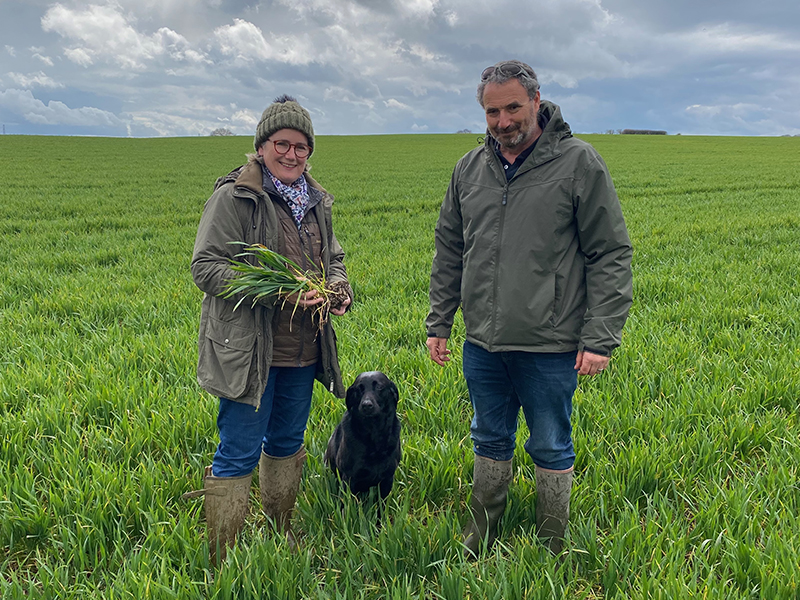Tweaking wheat nitrogen management improves drought tolerance
Dry springs and early summers are a risk that every winter wheat grower has to contend with from time to time. But along the north Kent coast these yield-sapping events are all too common, particularly on heavier soils prone to shallow rooting, which can quickly leave wheat crops high and dry.
Rainfall at DC Bartlett’s Brooklands Farm, Whitstable averages just 635mm (25 inches) a year. During May to July useful rainfall can be especially scarce, stressing crops in the critical yield building period.
“We are in a very dry spot,” says Annie Bartlett. “Essex is said to the be driest in the country, but we are only a stone’s throw away and not far behind. Crops can soon start losing potential.”
A move to direct drilling seven years ago, triggered by a serious blackgrass infestation that threatened the viability of winter cropping on the farm’s 400ha of heavy London clay, has helped produce more robust crops that can cope better with dry weather.
Vigorous rooting
Much-improved blackgrass control has enabled a return to earlier drilling, while soil structure is recovering; both are helping crops produce more vigorous rooting systems.
“We used to aim to finish our wheat drilling on 25th October, but often had to go past that,” says Annie. “Last year we were done by 12th October.
“We are also finding that soils are improving; fields are travelling a lot better and tramlines are firmer.”
Nevertheless, crops can still suffer when dry weather hits. However, a decision last year to change late nitrogen management across the farm’s 135ha of winter wheat looks set to improve matters further.
In response to high nitrogen prices, Agrovista agronomist Rob Purvis recommended that Annie try MZ28, a foliar-applied slow-release nitrogen fertiliser that sticks to leaves and feeds crops for several weeks after spraying.
“The product has been developed to replace the final split of nitrogen, timed between T1 and T2 when there is plenty of canopy to target,” says Rob.
“The polymers in the product coat the foliage and lock into place, feeding the plant over six to eight weeks, whatever the weather.
Efficient nutrition
“This is a very efficient process resulting in 85-95% utilisation of applied nitrogen, which is why it can be used at such a low rate. We used it at 35 litres/ha, which provides the equivalent of 50kg/ha of solid nitrogen. Cost-wise MZ28 was very useful last year.”
This year the advantage has narrowed, although MZ28 still remains slightly more cost-effective.
“In addition, we’re now putting on 170kg of N earlier in two splits, then topping up with MZ28 just prior to flag leaf emergence. Beforehand we might have combined the last two splits if it looked like turning dry, which is obviously less efficient.”
As well as being very cost effective, the product also boosted crop performance in what turned out to be a very dry late season.
“Being able to feed through the leaf gave us a real advantage in those conditions,” says Rob. “Crops yielded well in a potentially difficult year.”
Annie noticed that crops held on much better. “MZ28 kept feeding the crops through the dry spell. Like everyone we had a good harvest, but I’m convinced the 8.5t/ha average we achieved was better than had we not used the product.”
Ian Gent, who carries out the farm’s crop walking and spraying duties, added: “Even if cost was the wrong way we’d carry on using it, because of the way the weather patterns work here, and because the product is so efficient. You know the vast majority of what you are applying will be taken up by the plant.""
Blackgrass suppression
Another potentially very useful benefit that has yet to be assessed at Brooklands Farm is blackgrass suppression.
“MZ28 is applied to the wheat canopy at a time blackgrass plants are still below it, so they receive much less nitrogen than with a soil-applied source,” says Rob.
“Because we treated all the wheat at Brooklands we couldn’t compare MZ28 against the standard programme. But the product has definitely proved useful elsewhere in this respect.
“In trials conducted at Lamport AgX, our heavy land trials site in Northamptonshire, we saw a statistically significant reduction in the number of blackgrass heads/sq m where we fed the crop and not the blackgrass.”


